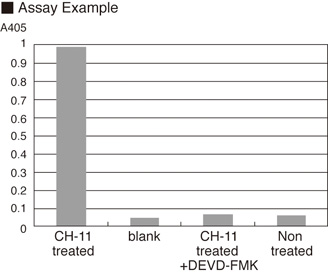APOPCYTO Caspase-3 Colorimetric Assay Kit
| Code | Size | Price |
|---|
| MBL-4800 | 100 Assays | £373.00 |
Quantity:
Prices exclude any Taxes / VAT
Overview
Regulatory Status: RUO
Shipping:
dry ice
Storage:
-20°C. Please refer to datasheet for additional information
Images
Documents
Further Information
Description:
Caspases are members of the cysteine aspartic acid-specific protease family,
which may be activated by a variety of signals including death receptor ligation,
DNA damage, serum starvation, stress, and many more. Active caspases
recognize a wide number of different substrates, leading to the activation of several different apoptotic pathways. For example, CAD (caspase-activated deoxyribonuclease), a protein involved in chromatin fragmentation into nucleosome units, is indirectly activated by caspase-3, while ICAD (inhibitor of caspase-activated deoxyribonuclease) is inactivated by caspase-3. The cleavage of several structural proteins by caspases leads to the unique apoptosis cell morphology of chromatin condensation, nucleus fragmentation and
cytoplasmic integrity. Detection of caspase activity is recognized as a standard method to measure apoptosis activity. The most common method to measure
caspase activity is via the fluorometric or colorimetric detection of the cleavage of caspase-specific substrates.
Gene IDs:
Human: 836 Mouse: 12367
Kit Components:
Cell Lysis Buffer, 2X Reaction Buffer, DTT, Substrate DEVD-pNA, Inhibitor DEVD-FMK, pNA (p-nitroanilide)
Shelf Life:
see label
Target:
Caspase-3
References
1). Adachi M, et al., Clin Cancer Res, 10, 3853 (2004)
2). Brigotti M, et al., Infect Immun, 75, 2201 (2007)
3). Dinnen RD, et al., J Biol Chem, 282, 26675 (2007)
4). Goga Y, et al., J Dent Res, 85, 240 (2006)
5). Ishii T, et al., Cancer Res, 65, 203 (2005)
6). Madsen-Bouterse SA, et al., Endocrinology, 147, 3826 (2006)
7). Min Y, et al., Gut, 54, 591 (2005)
8). Nozaki N, et al., Circulation, 110, 2869 (2004)
9). Numata K, et al., J Immunol, 178, 3777 (2007)
10). Sinicrope FA, et al., Clin Cancer Res, 10, 8284 (2004)




